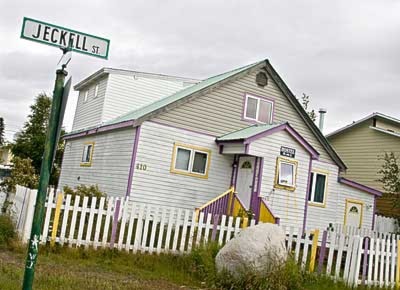There’s a youth shelter schism in Whitehorse.
And it’s the homeless kids who’re suffering, says Youth of Today Society executive director Vicki Durrant.
Late last week, youth agencies and government representatives met to discuss long-term youth shelter options.
Youth of Today tabled its plans to buy the Hide on Jeckell hostel and set up an independent living program.
The society put a $50,000 down payment on the building and has begun an ambitious fundraising campaign.
The hostel is perfect, said Durrant.
Already zoned for such a use, the building has a library, 22 beds, music, computers, a kitchen and common areas.
Youth of Today is calling it Angel’s Nest in memory of Angel Carlick, who had spent some of her life homeless and was working to set up a shelter when she went missing on May 31st, 2007.
Her body was found five months later near Pilot Mountain subdivision.
Thursday’s meeting saw representatives from Bringing Youth Toward Equality, the Whitehorse Boys and Girls Club, Health and Social Services, Youth of Today and Skookum Jim Friendship Centre.
Michelle Kolla, Skookum’s executive director, chaired the meeting.
The Angel’s Nest project was laid out by Lance Burton, of Youth of Today.
“I don’t know anything about it — just what I heard in the media,” said Kolla in an interview with the News on Friday morning. “We’re not part of that, we don’t have information on that.”
“I’m not involved. I don’t know enough about it to support it.”
So, after a brief summary of the Angel’s Nest project, Kolla was asked if the dedicated shelter was something Skookum Jim would be interested in pursuing.
“No,” said Kolla.
Skookum Jim is currently running a $191,000 youth-shelter pilot project with beds at sites scattered throughout Whitehorse.
Originally planned to run from March through May, the program has been extended until the end of August.
Youth call a hotline and if they fit the criteria, they are given a bed or referred to other agencies.
The only identified beds are a pair at Alcohol and Drug Services.
By April, there had been 32 requests for service and 15 referrals, said Kolla in a previous interview.
“Skookie’s is an interim solution,” said Whitehorse Youth Coalition co-chair Dave Prodan.
“It’s something that’s working and, for the time being, it’s something we’re all hoping will keep going until we do find a long-term solution.”
Angel’s Nest is a long-term solution, but there’s a turf war with Skookum Jim staff.
“I know there are some ideological differences on how this is going to pan out, and I think that’s what’s causing this confusion between what the Youth of Today Society and Skookie’s wants to do,” said Prodan.
It doesn’t have to be one or the other, said Bringing Youth Toward Equality’s executive director Rachel Parks.
“I’ve had people coming and saying, ‘Which one should I support?’” she said.
“But you can support both — they compliment each other.”
Skookum Jim is running an emergency youth shelter, while Youth of Today is hoping to set up supportive, independent living, said Parks.
“And there are still not enough beds.”
Thursday’s meeting was the first Andrew Finton attended.
“I was surprised at the meeting that there seemed to be these two separate camps,” said the Sundog carving program co-ordinator.
“I’d sooner see the two teams working together.
“By pitting one against the other, the people who are going to lose here are the kids.”
Both Skookum Jim and Youth of Today are trying to help solve the youth homelessness problem, said Finton, who’s referred some of his students to Skookum Jim’s shelter pilot.
“What (Skookum Jim’s is) doing is a good thing,” he said.
“But I also think the idea of a permanent emergency shelter is crucial.”
Currently, four kids in Finton’s carving program are living in tents. Another two are couch surfing.
“There’s lots of talk about the youth initiatives to try and get kids healthy and get them off the streets and lower youth crime,” he said.
“And that’s what our program is doing; we’re overrun. We have 23 kids and we can barely keep up.
“But we’re just one part of the puzzle.”
Homeless youth don’t just need a bed, said Finton.
“It’s not as simple as putting out a couple of hundred thousand dollars and fixing the problem.”
A kid coming in off the street will likely need housing, have addiction issues, need counseling, advocacy, job training, and life skills, he said.
“So a lot of it boils down to the government looking at the youth/homelessness issue as a real priority in terms of helping our youth.
“I think the feeling is, there’s this half million we’re going to spend on youth homelessness, and we can only give it to one agency — which should it be?
“And I don’t think that’s really the answer. The answer is to say the pot needs to be enlarged so we’re not putting Band-Aid solutions on problems — ideally this will get the two teams working together.
“It should be that both of these are essential services and we should be sitting down at the table and adding more money to the pot so that both services can run.
“It shouldn’t be either/or.”
There needs to be a range of services where troubled youth get counselling and support, he added.
“There needs to be more attention paid to this problem.
“Otherwise kids are just going to keep showing up dead, or so abused and so damaged it’s a sin.”
